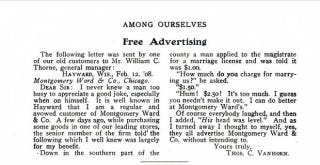National Mail Order Gardening Month
Holiday catalogs are beginning to arrive as Christmas approaches. Many are impersonally addressed to "current resident," then tossed without a second glance. But catalogs in the U.S. have a surprising early history of getting up close and personal with customers.
In the early years of the mail-order catalog business, employees answered customer letters personally. Even the founder of Montgomery Ward & Co., Aaron Montgomery Ward, responded personally to customer letters. Such correspondence might seem quaint today, but those messages were a serious sales strategy.
For many rural consumers, mail-order catalogs seemed risky. In 1890, 64 percent of Americans lived in rural communities, according to the U.S. census. The custom for most rural Americans was to buy from local merchants or the occasional wandering peddler. Although mail-order companies offered a wider variety of products and competitive prices, the company was a stranger. Mail-order companies had to instill confidence that buying from a stranger was safe. Putting a name with a face and adding the touch of personal communication was a sales strategy that worked.
"Sears insisted his employees handwrite notes instead of using a typewriter—some customers were offended to receive a letter that came from a machine."
Companies such as Sears Roebuck & Co. and Montgomery Ward & Co. sent products from Chicago to remote ranchers and far-flung farmers. Although Richard Warren Sears was not known for sending out the letters that Ward did, Sears insisted his employees handwrite notes instead of using a typewriter—some customers were offended to receive a letter that came from a machine.

Ward also sensed opportunity to build a relationship through the mail. He included photographs of his top executives in the catalog, as well as buyers for specific departments so that customers would know to whom they were writing.
In their return letters, employees offered congratulations for marriages, the arrival of a new baby, or a condolence for the loss of a family member. These messages had meaning for many customers, and some even sent letters thanking employees for their support.
The sales strategy helped convince hesitant customers to place an order. But it also had a surprising side effect. Isolated and lonely customers enjoyed the personal correspondence and included with order forms the type of personal letter that one might send to a pen pal.
Customers gave updates on their lives and even explained why they hadn't ordered in a while. One farmer wrote to Mr. Ward, detailing why he hadn't made a purchase since the previous fall catalog: "Well, the cow kicked my arm and broke it and besides my wife was sick, and there was the doctor bill. But now, thank God, that is paid and we are all well again, and we have a fine baby boy, and please send plush bonnet number 29d8077..."

Letters from the catalog company were a lifeline for many customers. In 1900, every state west of the Mississippi River had a population density of less than 25 people per square mile of land. For customers living in the states such as North Dakota, farming or ranching was indeed a lonely experience—the population was as few as five people per square mile. And there was no radio, television, or any kind of mass communication to connect a person with the larger world.
For some customers, the reliability of the catalogs and the kindness of the correspondence led to an unrealistic trust in the company. On multiple occasions, lonely farm men asked the Montgomery Ward & Co. to send a pair of boots as well as a wife. Ward responded personally to such inquiries, and suggested that finding a spouse was a personal choice best done in person.
"On multiple occasions, lonely farm men asked the Montgomery Ward & Co. to send a pair of boots as well as a wife."
The customer letters to Montgomery Ward & Co. employees, unbeknownst to the writers, were regularly published in the company's monthly employee newsletter, Among Ourselves. The most silly, touching, and notable letters were included. The newsletter editor admitted to shedding a few tears when an Ohio boy with amputated limbs wrote and asked if he could work for the company to pay off a toy purchase.

On a lighter note, a Wisconsin man wrote and boasted how everyone in his community knew he was a staunch Ward customer. While he was in town, he heard a joke about how Ward could supply a marriage license for cheaper than the county clerk. The letter-writer felt the joke was repeated for his benefit and was proud others associated him as a Ward customer.
The need for a personal touch ended within a few decades. By 1920, the U.S. population was slightly more urban than rural. There were fewer lonely customers eager to receive a letter from a catalog company across the country. And there were more competitors—many with credit programs. Sadly, although catalogs still arrive in the mail, the time when a customer included a personal note with an order form and received a response has long gone out of fashion.
This content is created and maintained by a third party, and imported onto this page to help users provide their email addresses. You may be able to find more information about this and similar content at piano.io
National Mail Order Gardening Month
Source: https://www.countryliving.com/shopping/news/a40276/mail-order-catalogs/
Posted by: maloneruty2001.blogspot.com

0 Response to "National Mail Order Gardening Month"
Post a Comment